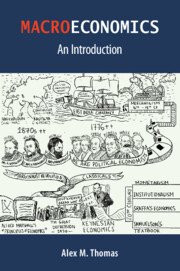Book contents
- Frontmatter
- Dedication
- Contents
- List of Illustrations
- List of Figures
- List of Tables
- Preface
- Acknowledgements
- Note to the Reader
- 1 What is Economics
- 2 Conceptualising the Macroeconomy
- 3 Money and Interest Rates
- 4 Output and Employment Levels
- 5 Economic Growth
- 6 Why Economic Theory Matters
- 7 The Policy Objective of Full Employment
- 8 The Policy Objective of Low Inflation
- 9 Towards Good Economics
- Data Sources
- References
- Index
8 - The Policy Objective of Low Inflation
Published online by Cambridge University Press: 08 June 2021
- Frontmatter
- Dedication
- Contents
- List of Illustrations
- List of Figures
- List of Tables
- Preface
- Acknowledgements
- Note to the Reader
- 1 What is Economics
- 2 Conceptualising the Macroeconomy
- 3 Money and Interest Rates
- 4 Output and Employment Levels
- 5 Economic Growth
- 6 Why Economic Theory Matters
- 7 The Policy Objective of Full Employment
- 8 The Policy Objective of Low Inflation
- 9 Towards Good Economics
- Data Sources
- References
- Index
Summary
Introduction
When the prices of essential commodities like dal (pulses) and onions increase, it makes headlines in newspapers. It is similar with fuel (petrol and diesel) prices too. If we have at our disposal the knowledge regarding the determinants of these prices, then we can formulate policies aimed at reducing the prices. In the preceding chapters, we discussed the macro determinants of aggregate output (Section 4.2), the nature of India's financial architecture (Section 3.2) and the significant presence of informality in the Indian economy (Section 6.4). It will presently be seen (in Section 8.2) that a brief understanding of the aforementioned empowers our attempt to understand the nature of inflation.
This chapter introduces you to the nature of inflation—the rise in aggregate price level over a sustained period of time—by measuring its various aspects and posing several questions for you to ponder over. The measurement of aggregate price level requires the aid of the statistical device of index numbers, which is an average of a special kind. After outlining the problem of high inflation, the chapter provides a range of broad macroeconomic solutions relevant to the Indian context. Before we get into the details of inflation, note that the primary objective of the Reserve Bank of India (RBI), as mentioned on its website, is “to maintain price stability while keeping in mind the objective of growth”.
To reiterate, the primary aim of economics, following Smith, is to ensure “a plentiful revenue or subsistence for the people”. This warrants not only reliable and gainful full employment, but also that the purchasing power of wages witnesses an improvement in line with the evolution of people's social needs. Or, at the very least, the purchasing power of wages ought to remain steady. This chapter focuses on commodity flows and money flows, both of which influence commodity prices. It takes Keynes's assumption of a ‘monetary production economy’ seriously to arrive at an understanding of inflation. The chapter concludes by arguing that the policies to combat inflation warrant the joint forces of fiscal and monetary policies.
The nature of inflation in India
Inflation, as noted in the introductory section, is the persistent rise in the aggregate price level (P) over a period of time.
- Type
- Chapter
- Information
- MacroeconomicsAn Introduction, pp. 163 - 185Publisher: Cambridge University PressPrint publication year: 2021

